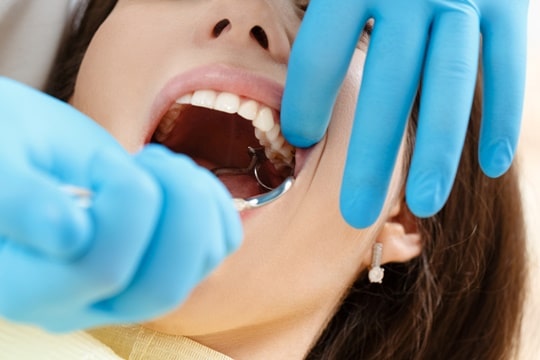Wisdom Tooth Extraction
The third (and final set) of molars many people get in their early twenties or late teens is called wisdom teeth. When properly aligned and healthy, the wisdom teeth can be a valuable addition. In many cases however, they are often misaligned and may require removal.
When misaligned, your wisdom teeth can be angled away or toward the second molars. They can also be angled outward or inward or may be positioned horizontally. Poor wisdom teeth alignment may crowd adjacent teeth and cause damage to the teeth, nerves, or jawbone.
Your wisdom teeth can also become impacted when they only partially erupt through the gum or when they are enclosed within the jawbone or soft tissue. Partial eruption of the wisdom teeth may provide an opening for bacteria and cause infection. This can result to swelling, jaw stiffness, and pain.
Wisdom teeth that are partially erupted are also more susceptible to gum diseases and tooth decay since their awkward positioning and hard-to-reach location makes flossing and brushing very difficult.

Do I have a wisdom tooth?
Visit your dentist and ask about the positioning of your wisdom teeth. To evaluate the presence and alignment of the wisdom teeth, an X-ray may be taken periodically. Your dentist will also be the one to decide if you need to visit an oral surgeon for further evaluation.
Your dentist can give recommendations if your wisdom teeth need extracting before any problems can develop. This is also done to help ensure a more complicated and painful extraction a few years down the road is avoided.
Wisdom teeth removal is often easier in young people since the bone is less dense and the roots are not fully developed yet. In older people, there is a tendency for the recovery and healing time to last longer.
Am I suitable for a wisdom tooth extraction?
When there is no sufficient room in your mouth to allow the third molars to fully erupt, multiple dental problems can occur. Ideally, impacted wisdom teeth should be extracted before the tooth structure develops fully.
In some patients, the wisdom teeth can emerge as early as 12 or 13 years old. In others, the wisdom teeth won’t appear until they are in their early twenties. Oftentimes, dental problems are likely to occur when the wisdom teeth emerge after the age of 30.
Some of the cases that might warrant removal of the wisdom teeth include:
- One of the most frequent clinical problem related to wisdom teeth is localised gum infection or pericoronitis. Without ample room for total eruption to happen, the gum tissue surrounding the wisdom tooth can get infected and irritated. This can result in swelling, recurrent pain, and problems with swallowing or chewing.
- Wisdom teeth that are impacted may result in crowding. There are numerous dental factors that can cause crowding and impacted wisdom teeth is considered one of the likely contributing factors. Removal of wisdom teeth is recommended to avoid any long-term damage to the gums, teeth, and jawbone.
- Cyst Formation. Non-infectious diseases can occur as a result of impacted wisdom tooth. Cysts are fluid-filled “balloons” that develop inside the jawbone as a result of an impacted wisdom tooth and may slowly spread and destroy the adjacent jawbone. Dental treatment can become difficult when it is left unattended for many years. While rare, tumours are sometimes associated with delayed wisdom teeth removal as well, which is easily preventable with a dental treatment.
Adjacent Teeth Damage. If there is no adequate room to conduct a dental cleaning round the wisdom tooth, the adjacent tooth directly in front of it can be adversely affected and can result in decay, bone loss around the tooth, and gum disease.
How are wisdom tooth extracted?
The ease at which your dentist can remove your wisdom teeth will depend on two factors—your wisdom teeth’s stage of development and position. When extraction of your wisdom teeth is needed, your dentist will be able to give you an insight on what to expect before, during, and after the wisdom tooth procedure.
When your wisdom tooth has not fully erupted through your gums, it can be extracted as easily as any other tooth. However, if the wisdom tooth is situated underneath the gums and embedded in the jawbone, an incision into the gums and dental removal of the bone portion that lies over the tooth may be required.
In similar scenarios, the wisdom tooth will be extracted in small sections as opposed to remove in one piece. This is done to minimise the amount of bone that will be removed in order to get the tooth out.
What do I expect after a wisdom tooth extraction?
After your wisdom teeth is removed, the speed of recovery will depend largely on the difficulty of the extraction. For instance, you can expect different recovery speeds between a tooth impacted into a jawbone versus a fully erupted tooth.
Generally, here’s what you can expect after the procedure:
The first 24 hours
Bleeding can occur several hours after the extraction of your wisdom tooth. To help minimise bleeding, you can position a clean moist gauze on the tooth socket and bite down firmly. Make sure constant pressure is applied for at least 45 minutes. The procedure is ideal for minimal bleeding. If heavy bleeding occurs after a wisdom tooth extraction, getting in touch with your dentist is recommended. Also, refrain from spitting or rinsing for 24 hours after your wisdom tooth has been removed. Sucking actions like smoking or drinking beverage using the straw should also be avoided. Activities mentioned earlier should be avoided for the time being as it can dislodge the clot, resulting to a dry socket.
- Swelling in the facial area where the wisdom tooth was extracted can occur. To minimise the swelling, wrap a piece of ice in a clean cloth and place it on the affected area of the face for at least 10 minutes. A 20-minute rinse off should follow each time. Repeat as needed during the first 24- hour period.
- Pain medications like ibuprofen or acetaminophen may be prescribed to ease minor pain. However, your dentist may prescribe a more powerful pain reliever when the need calls for it.
- You need to continue taking antibiotics that have been prescribed prior to the wisdom tooth extraction. In some cases, antibiotics are prescribed prior to wisdom tooth extraction to treat any active infection around the tooth to be extracted. The antibiotics should be taken continuously until the full prescription has been consumed.
- You are restricted to a liquid diet the first 24 hours.A liquid diet is recommended within the first 24 hours after the wisdom tooth procedure or after the anaesthesia has worn off. You might also be advised to eat soft foods, at least for the first few days after the dental procedure.
- You can still brush your teeth.However, you need to avoid brushing the teeth directly adjacent to the wisdom tooth that has been extracted during the first 24 hours. Mouth rinses need to also be avoided for the time being until the site has healed fully.
















